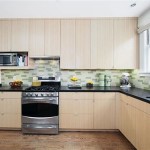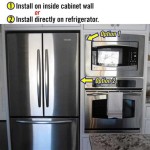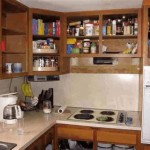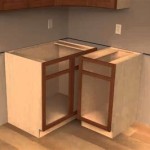How to Get Grease Off of Kitchen Cabinets
Kitchen cabinets, especially those located near the stove, are highly susceptible to accumulating grease. This greasy film isn't just unsightly; it can also trap dirt and dust, making the cabinets look even more unkempt and potentially damaging the finish over time. Regular cleaning is essential to maintain the appearance and longevity of the cabinetry. Removing grease effectively requires understanding the types of grease, the cabinet materials, and the appropriate cleaning methods.
The type of grease found on kitchen cabinets is primarily composed of cooking oils, fats, and food particles that become airborne during cooking. The heat from the stovetop causes these substances to vaporize and circulate throughout the kitchen, eventually settling on surfaces like cabinets. Over time, these deposits accumulate and can harden, making them more difficult to remove. The composition of the grease can also vary depending on the cooking habits of the household. For example, frequent frying will result in a higher concentration of oil-based grease, while baking might leave behind a residue that includes flour and sugar.
Before attempting to clean any kitchen cabinets, it's crucial to identify the material they are made of. Common cabinet materials include wood (both solid and veneer), laminate, painted surfaces, and metal. Each material reacts differently to cleaning agents. Using the wrong cleaner can damage the finish, leading to discoloration, peeling, or warping. Wood cabinets, particularly those with a natural finish, are more porous and susceptible to water damage than laminate or metal. Painted cabinets can be prone to chipping if scrubbed too aggressively.
A preliminary assessment of the grease buildup is also important. Light buildup might require a gentle cleaning solution and minimal scrubbing. Heavier, more stubborn grease may necessitate a stronger degreaser and more intensive cleaning techniques. Ignoring the severity of the grime can lead to unnecessary damage from overly harsh cleaning practices, or ineffective results from a too-gentle approach.
Gathering the Necessary Cleaning Supplies
The success of any cleaning project depends on having the right tools and supplies. For cleaning grease off kitchen cabinets, the following items are generally recommended:
*Cleaning Solutions:
Several options exist, ranging from commercially available degreasers to homemade solutions. Dish soap is a common and effective choice for mild grease buildup. For heavier grease, solutions containing vinegar, baking soda, or mild all-purpose cleaners may be necessary. Always test any cleaning solution in an inconspicuous area before applying it to the entire cabinet surface. *Cleaning Cloths and Sponges:
Microfiber cloths are excellent for cleaning cabinets because they are soft, absorbent, and won't scratch the surface. Non-abrasive sponges can also be used, but avoid using steel wool or scouring pads, as they can damage the finish. A soft-bristled brush can be helpful for reaching into crevices and corners. *Spray Bottle:
A spray bottle is useful for applying cleaning solutions evenly to the cabinet surfaces. This allows for controlled application and prevents excessive soaking, which can be detrimental to certain cabinet materials. *Warm Water:
Warm water is generally more effective at dissolving grease than cold water. It is used for diluting cleaning solutions and rinsing the cabinets after cleaning. *Protective Gear:
Gloves are recommended to protect hands from the cleaning solutions. Eye protection is also advisable, especially when using spray bottles, to prevent accidental splashes. *Optional Items:
A plastic scraper can be used *very carefully* to remove stubborn spots of hardened grease. Always test the scraper in an inconspicuous area first to ensure it does not damage the finish. Paper towels can be used for drying the cabinets after cleaning, although microfiber cloths are reusable and generally preferred.Step-by-Step Cleaning Process
The cleaning process should be approached methodically to ensure effective grease removal and prevent damage to the cabinets. The following steps provide a general guideline:
1.Preparation:
Clear the countertops beneath the cabinets to prevent drips and splatters from damaging them. Cover the countertops with a drop cloth or towels to protect them further. Remove any items from the cabinet shelves to allow for thorough cleaning, both inside and out of the cabinet doors. 2.Dusting:
Use a dry microfiber cloth or a vacuum cleaner with a brush attachment to remove any loose dust or debris from the cabinet surfaces. Dusting before cleaning prevents the dust from mixing with the cleaning solution and creating a muddy mess. 3.Testing the Cleaning Solution:
Before applying any cleaning solution to the entire cabinet surface, test it in an inconspicuous area, such as the inside of a cabinet door or the back of a drawer. This will ensure that the solution does not damage the finish or cause discoloration. Allow the test area to dry completely before proceeding. 4.Applying the Cleaning Solution:
Lightly dampen a clean microfiber cloth or sponge with the chosen cleaning solution. Wring out any excess liquid to prevent drips. Gently wipe the cabinet surfaces, focusing on areas with visible grease buildup. Avoid scrubbing too hard, as this can damage the finish. If using a spray bottle, spray the cleaning solution directly onto the cloth rather than spraying it directly onto the cabinets. 5.Addressing Stubborn Grease:
For stubborn grease spots, allow the cleaning solution to sit on the affected area for a few minutes to soften the grease. Then, gently scrub with a non-abrasive sponge or a soft-bristled brush. If necessary, use a plastic scraper *very carefully* to remove hardened grease. Be sure to protect the surrounding surfaces with a cloth when scraping. 6.Rinsing:
After cleaning, rinse the cabinets with a clean, damp cloth to remove any remaining cleaning solution. Use warm water to rinse the cloth frequently. Ensure that all traces of the cleaning solution are removed, as they can leave a residue that attracts dirt. 7.Drying:
Dry the cabinets thoroughly with a clean, dry microfiber cloth or paper towels. Drying prevents water spots and helps to maintain the finish. Pay particular attention to drying the edges and corners of the cabinets, where water can accumulate. 8.Polishing (Optional):
For wood cabinets, a furniture polish can be applied after cleaning to protect the finish and add shine. Follow the manufacturer's instructions for applying the polish. Avoid using furniture polish on laminate or painted cabinets, as it can leave a greasy residue.Specific Cleaning Solutions Based on Cabinet Material
The following guide provides specific cleaning solution recommendations based on common cabinet materials:
*Wood Cabinets (Solid and Veneer):
A mild dish soap solution is generally safe and effective for wood cabinets. Mix a few drops of dish soap with warm water and use a damp cloth to clean the cabinets. Avoid using excessive water, as it can damage the wood. For stubborn grease, a solution of equal parts vinegar and water can be used. Always test the solution in an inconspicuous area first. Avoid abrasive cleaners and scouring pads, as they can scratch the finish. *Laminate Cabinets:
Laminate cabinets are relatively easy to clean. A mild all-purpose cleaner or a dish soap solution can be used. Avoid using abrasive cleaners or scouring pads, as they can scratch the laminate surface. For stubborn grease, a solution of baking soda and water can be used to form a paste. Apply the paste to the grease spot, let it sit for a few minutes, and then gently scrub with a soft cloth. *Painted Cabinets:
Painted cabinets can be cleaned with a mild dish soap solution or a commercially available cabinet cleaner designed for painted surfaces. Avoid using abrasive cleaners or scouring pads, as they can chip the paint. For stubborn grease, a solution of vinegar and water can be used, but test it in an inconspicuous area first to ensure it does not damage the paint. *Metal Cabinets:
Metal cabinets are durable and relatively easy to clean. A mild all-purpose cleaner or a dish soap solution can be used. For stubborn grease, a solution of baking soda and water can be used. Avoid using abrasive cleaners, as they can scratch the metal surface. After cleaning, dry the cabinets thoroughly to prevent rust.It is always advisable to consult the cabinet manufacturer's instructions for specific cleaning recommendations. Following the manufacturer's guidelines will help to ensure that the cabinets are cleaned effectively and without damage.
Maintaining clean kitchen cabinets is a continuous process. Regular cleaning prevents grease buildup from becoming severe and difficult to remove. Wiping down the cabinets after each use of the stovetop will significantly reduce the accumulation of grease and keep them looking their best. A consistent cleaning routine ultimately extends the life of the cabinets, saving on potential replacement or refinishing costs. By adopting the correct cleaning methods and adhering to a regular schedule, maintaining the pristine condition of kitchen cabinets can be achieved with relative ease.

How To Remove Grease From Kitchen Cabinets 3 Methods Bob Vila

How To Clean Sticky Grease Off Kitchen Cabinets Ovenclean

Get Grease Off Kitchen Cabinets Easy And Naturally

Best Ways To Clean Grease Stains Off Kitchen Cabinets

Clean Kitchen Cabinets Off With These Tips And Hints

Get Grease Off Kitchen Cabinets Easy And Naturally

Degrease Kitchen Cabinets With An All Natural Homemade Cleaner

How To Clean Sticky Grease Off Kitchen Cabinets Infinity

How To Clean Sticky Grease Off Kitchen Cabinets

How To Clean Kitchen Cabinets Everyday Skate
Related Posts








